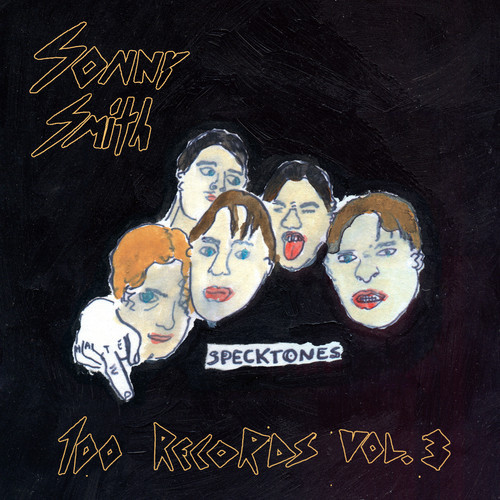Whether you enjoy Sonny Smith’s surf-inspired rock with Sonny & the Sunsets or feel that it’s a little too beholden to its influences, you can’t help but respect the man’s dedication to his craft—even more so when you understand the breadth and scope of his latest musical undertaking, the incredibly ambitious 100 Records project. Basically, Smith wrote and recorded 100 songs by 100 fictional artists and loaded them all with custom cover art into a mobile jukebox and took it on a short tour across the US, displaying it at small art galleries in various metropolitan cities. Having already released Volumes 1 & 2 through Polyvinyl Records, Smith has finally compiled and curated the last edition of the set. The numerically accurate 100 Records, Vol. 3 plays out very much like the previous releases in this series. The influences come fast and hard, and for the most part, each song never hangs around long enough to wear out its welcome, though that also means that some songs never really get a chance to establish themselves. But overall, this collection is enjoyable and even admirable, if not always successful.
It stands to reason, given the disparate nature of the songs, that Vol. 3 is going to feel a little more scattershot than any of his previous releases (aside from the previous 100 Records albums obviously). Here Smith draws on decades of musical history for his inspiration, and the often maniacal glee with which he parses out these hallowed and thoroughly deconstructed sounds is one of the overriding pleasures in hearing his take on so many different genres. Even the tracks that fail to find some sense of personal identity, regardless of their intended homage, are notable for the authenticity and painfully detailed reconstruction of their source material. Now, whether it’s the detailed restoration of Bob Dylan, Desmond Dekker, and ? and the Mysterians on the latest single “Half Boy Half Girl” or Smith doing his best Johnny Cash impersonation on “Cosmorama”, he lovingly devotes his time to making each influence stand front and center.
Sometimes though this slavish devotion comes at the cost of never fully developing many songs here and relegating them to curiosity status. Tracks such as the overly simplistic “Some Women Artists All Around Town” where Smith seems to be channeling his inner-Cowsills, and the embarrassingly insipid “From Dud to Stud, From Zero to Hero,” a tedious spoken-word account of the narrator’s sex life, keep this collection from rising to the heights found on the previous installments. It also doesn’t help that a number of tracks on Vol. 3 sound more like rough demos than finished songs, and maybe he wanted it that way, but it detracts greatly from the record. Having said that, it’s difficult to be too overly critical because of the sheer tenacity involved in a project of this magnitude—even with all the glaring mistakes that Smith has found fit to leave in place. The unreserved capacity of influences and diverse sounds that he is able to pile on top of one another without it feeling completely overwhelming is fascinating, and it’s done with such a deceptive ease.
Then again, critical perception of the songs never seemed to be an issue that Smith concerned himself with—not that that’s a prerequisite for any artist when recording obviously. But he seems far more concerned with the feel and sound of each track here. Songs like “If You Don’t Make a Change” and “Life Ain’t Clear” borrow heavily from the melodic pop of the 60’s, while “Fruitcakes” is textbook garage rock. One of the biggest surprises though comes in the form of “Space Travel’s In My Blood,” which sounds like Skeeter Davis crossed with The Count Five, where he talks about just wanting “a little space fuck.”
When viewed as a whole, Smith’s 100 Records project has few equals in terms of range and artistic possibilities. And while many people will see it simply as a by-product of Smith’s overactive creative impulses (and maybe that is part of it), this particular volume, and the project as a whole, should more appropriately be seen as a love letter to his heartfelt influences. His ability to refine and rearrange dozens of genres and to ingeniously process his own sense of critical revisionism makes this collection invaluable as an example of the lengths to which an artist can and will go to in order to see their own musical vision come to fruition. But when viewed on its own, Vol. 3 is a pleasant, though fundamentally flawed, ending to Smith’s musical journey.
If you’re asking whether the journey or the ending is what matters most, Sonny would probably keep silent on the subject. It’s both, of course. It’s all about personal perception. And in the case of this record, everyone will find something to latch onto—whether it’s a particular song or well-worn influence or simply Smith’s charming, albeit uneven, exploits through the past 50 years of musical history. While I’m not sure what possessed Smith to take on such a vast and intricate assignment, the resulting collection of songs that spread out across this final volume feel like an oddly appropriate, if not wholly satisfying, conclusion to his years of work on the project. If that sounds like less than a ringing endorsement, remember that this series of songs plays on the preferences of the listener, so it feels curiously tailored to each individual. And though Smith may have faltered a bit with this last set, the fact that he managed to record, and get distribution for, a project of this size—almost entirely on his own—is certainly something to be celebrated.

